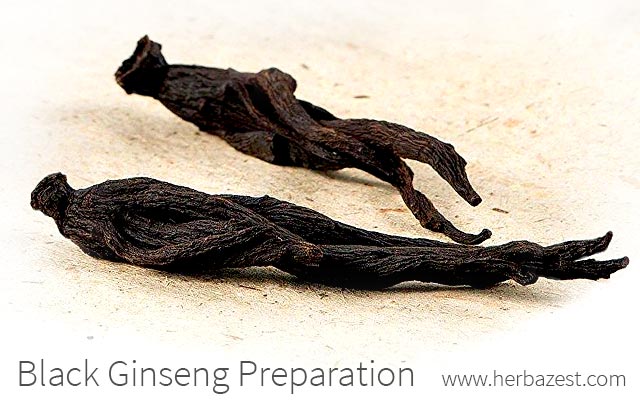Dried ginseng can be found in three main types - white, red, and black ginseng - depending on the procedure used to dry the Panax root. Korean black ginseng has been subjected to extensive research, as it is believed to be one of the most beneficial types of ginseng.
Black Ginseng vs. Other Ginseng Preparations
Depending on the processing method employed, each byproduct of ginseng has a particular chemical profile that makes it unique and useful in many ways. The protopanaxadiol class ginsenosides in red ginseng reach levels 2.5 times higher than in white ginseng, which in turn increases protopanaxatriol class ginsenosides. In Korean black ginseng, ginsenoside Rg3 (propanaxadiol) is enhanced, conferring its unique properties.
Black Ginseng Preparation
Although the equipment and method of preparation are not popularly known, and producing black ginseng is not exactly a home-friendly process, the standard method can be roughly summed up by the following steps:
- The fresh ginseng roots are dried for 20 - 28 hours at 68 - 131°F (20 - 55°C).
- Once dried, the ginseng roots are steamed for 1.5 - 5 hours at 176 - 248°F (80 - 120°C).
- The ginseng roots are dried again for 6 - 20 hours at 104 - 167°F (40 - 75°C).
- After a second round of steaming, the ginseng roots are dried for 1.5 - 4 hours at 176 - 230°F (80 - 110°C).
- The ginseng roots are wrapped in silk clothes to fix their shape.
- Once packaged, the ginseng roots are dried for 6 - 20 hours at 104 - 167°F (40 - 75°C).
At this point of the process, the humidity of the roots should be at least 20%. This process is repeated until the ginseng roots undergo a total of nine times of steaming and eight times of drying. The final product is black ginseng that shouldn't exceed 14% humidity.
How to Use Black Ginseng
It is fairly easy to work black ginseng into a daily nutritional routine, as it is available in a variety of forms. Black ginseng can be ground up into a powder form and be taken in a capsules, or it can be sprinkled over a large meal; however, Korean black ginseng candy and black ginseng extract are becoming increasingly popular ways of consuming the herb. A more creative and enjoyable method of receiving the benefits of black ginseng is through infusing the roots in wine.
Regardless of the form in which it is taken, the general dosage for any type of dried ginseng root is one to two grams daily.
Benefits of Black Ginseng
Black ginseng's particular method of production enhances some particular types of ginsenosides, thought to be responsible for the herb's unique benefits:
The antioxidant activities in black ginseng, significantly higher than in white ginseng, are believed to help treat and prevent cellular damage.
Black ginseng is widely consumed as an anti-diabetic supplement, since it effectively helps decrease high blood glucose levels.
Because of its influence on fat digestion, black ginseng has been connected to weight loss.
Along with other types of dried ginseng, black ginseng is commonly used to help treat hypertension, menopause symptoms, erectile dysfunction, and weak immunity.
Where to Buy Black Ginseng
Black ginseng can be found in some duty-free shops, and it is readily available online. Ordering different forms of black ginseng in a variety of dosages is very easy to do thanks to the herb's widespread popularity.
Black ginseng is a newly-emerging form of the multipurpose Panax root. So far, evidence shows that black ginseng is a very good source of ginsenosides. Further research will only help us to better understand the medicinal properties of this type of ginseng.
Sources
- Journal of Ginseng Research, Characterization of Black Ginseng Extract, 2010 | Effect of Black Ginseng on Memory Improvement, 2010 | Anti-obesity effects of black ginseng extract, 2013 | Comp. Study of Korean White, Red, and Black Ginseng Extract
- Journal of the Korean Society for Applied Biological Chemistry, Optimization of the manufacturing process for black ginseng, 2012
- Korean Journal of Food Science and Technology, Effects of Black Ginseng (9 Times-Steaming Ginseng) on Hypoglycemic Action and Changes in the Composition of Ginsenosides on the Steaming Process, 2009
- Plant Foods for Human Nutrition, Effect of white, red and black ginseng on physicochemical properties and ginsenosides, 2015




